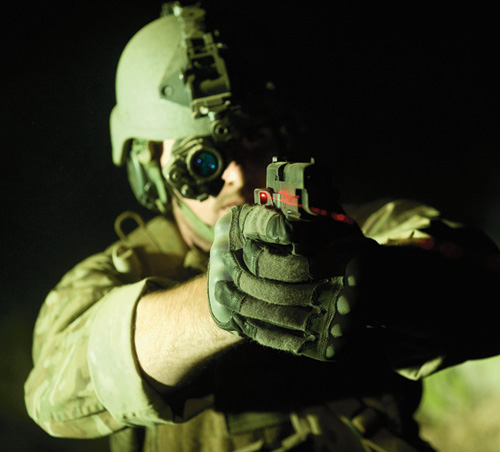 Wilsonville-based Crimson Trace makes state-of-the-art laser gun sights, employs around 100 people and controls 70% of the national market for laser gun sights.
Wilsonville-based Crimson Trace makes state-of-the-art laser gun sights, employs around 100 people and controls 70% of the national market for laser gun sights.
Crimson Trace makes red and green laser sights in addition to infrared sights for the military that require specialized goggles. This pistol is a “Sig 226.” |
As Lew Danielson read a worn, creased piece of yellow ruled notebook paper before work nearly 18 years ago he didn’t know he was reading the future.
Danielson is now the CEO and chairman of the board of Crimson Trace, the company he co-founded in 1994 based upon the mission statement that he wrote on that worn piece of paper dated “9/28/93” he now has framed in his office. The creased piece of paper has bullet points like “we will dominate the market” and “have top-notch customer service.” Following these and other simple guidelines has served them well. With revenues of between $40 million and $50 million, the Wilsonville-based company makes state-of-the-art laser gun sights, employs around 100 people and controls 70% of the national market for laser gun sights. It has seen a 10% to 12% annual growth rate for the past four years.
Danielson was formerly the president at EPS, a now-defunct Portland company that made parts for Boeing, when he decided to form Crimson Trace in 1996 to meld his professional experience and passion for shooting. The prototype laser sights were initially machined on weekends at EPS and were rather clunky; now the company uses CAD software to design the modular sights that are partially built by Hillsboro-based injection molding company R&D Plastics before being finished at the company’s Wilsonville factory “Oregon is a great place to start a business; you can start on a bootstrap,” says Danielson. “In California, you’re broke before you start,” he says, referring to permitting fees.
The company maintains its hold on the market through its military connections and research and development of new technologies. Crimson Trace hired ex-U.S. Special Forces agents Dale Suzuki and Jeff Hoblitt in 2009 to draw upon their military connections to land government contracts. Last August, the company announced a contract to supply the U.S. Navy Seals with invisible laser sights used in conjunction with specialized goggles.
|
The company specializes in laser sights that are integrated into gun grips |
Though its military contracts only account for roughly 5% of revenue (most of the business is with commercial clients such as law enforcement agencies), Crimson Trace spokesman Iain Harrison says he is confident that future contracts with the military will push the company forward. “The military is one of the most conservative institutions out there; it’s a big ship that is slow to turn,” he says. “But once they see it out in the field, they get on board.” Last year, the company had three engineering staffers designing new products. They now have 10.
Crimson Trace plans to capitalize on its partnership with Pennsylvania-based precision part maker CNC manufacturing to produce laser grips that can be custom-fitted for a customer using a variety of materials such as resin-reinforced wood.
Ever-changing products aside, a lot of it comes down to that bullet point about top-notch customer service.
“Americans are satisfied with poor service,” says Danielson. “We want raving fans.”
Peter Beland



